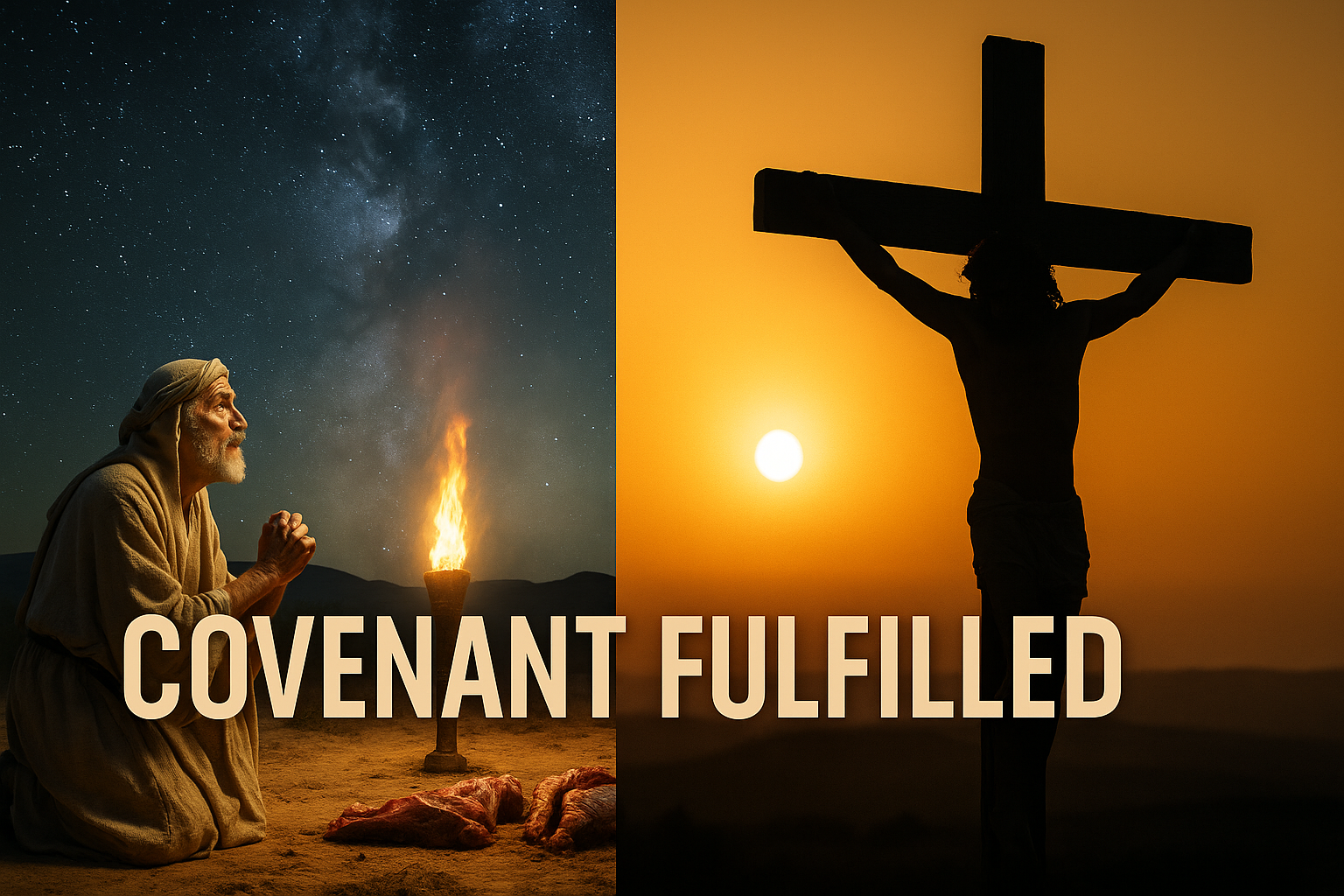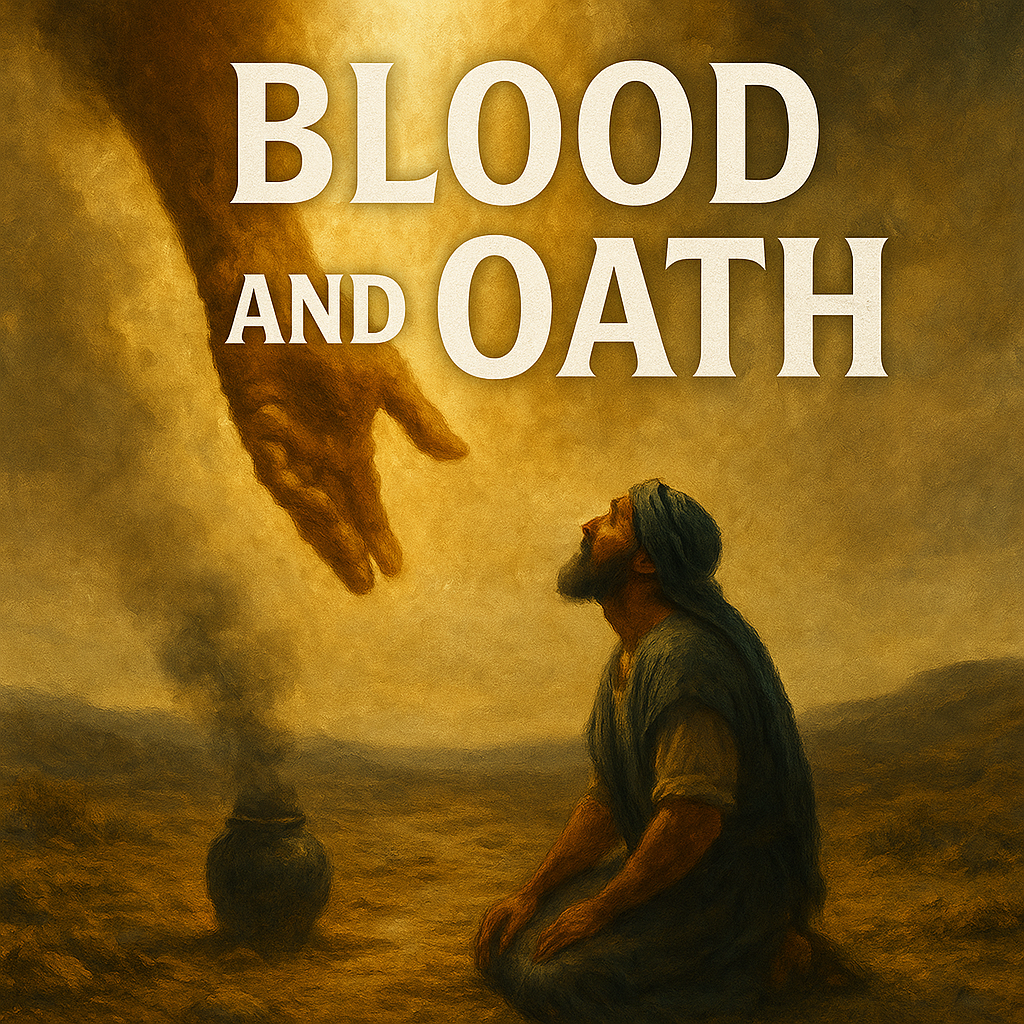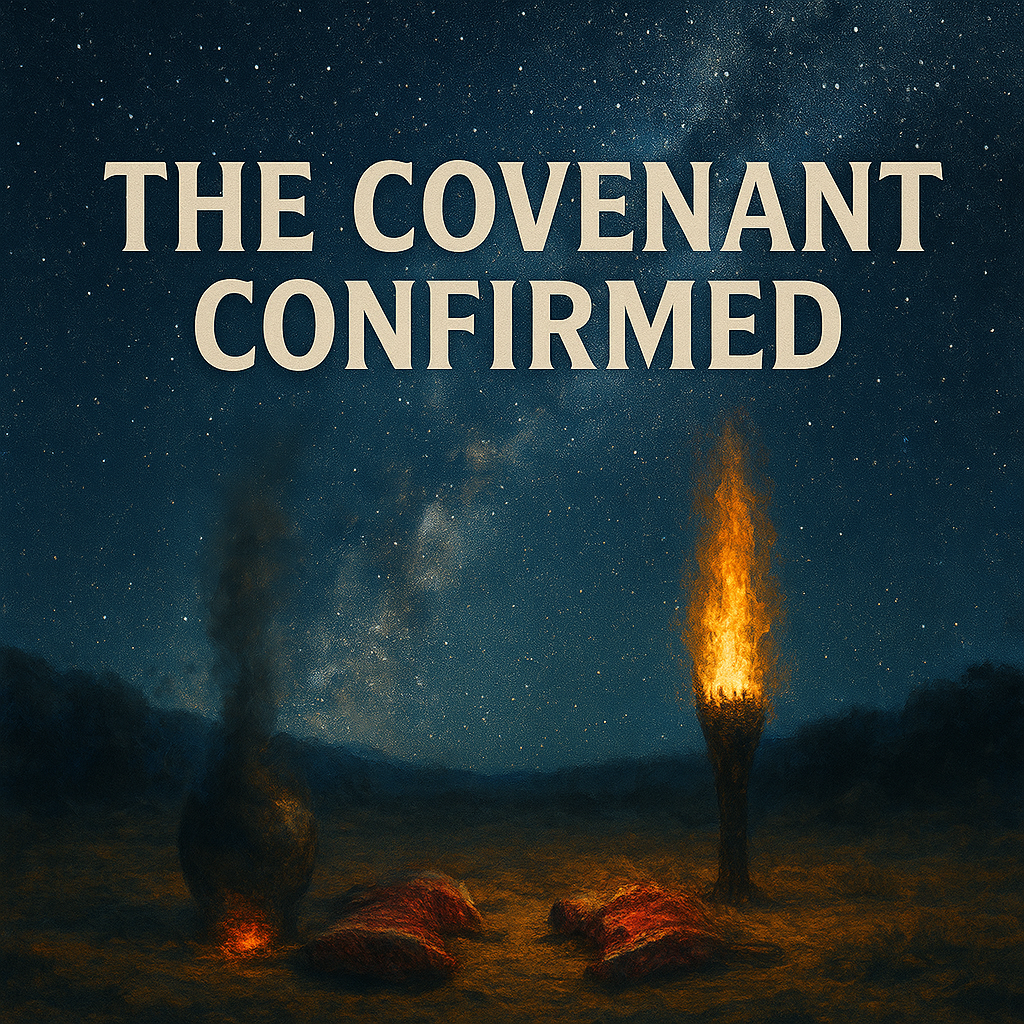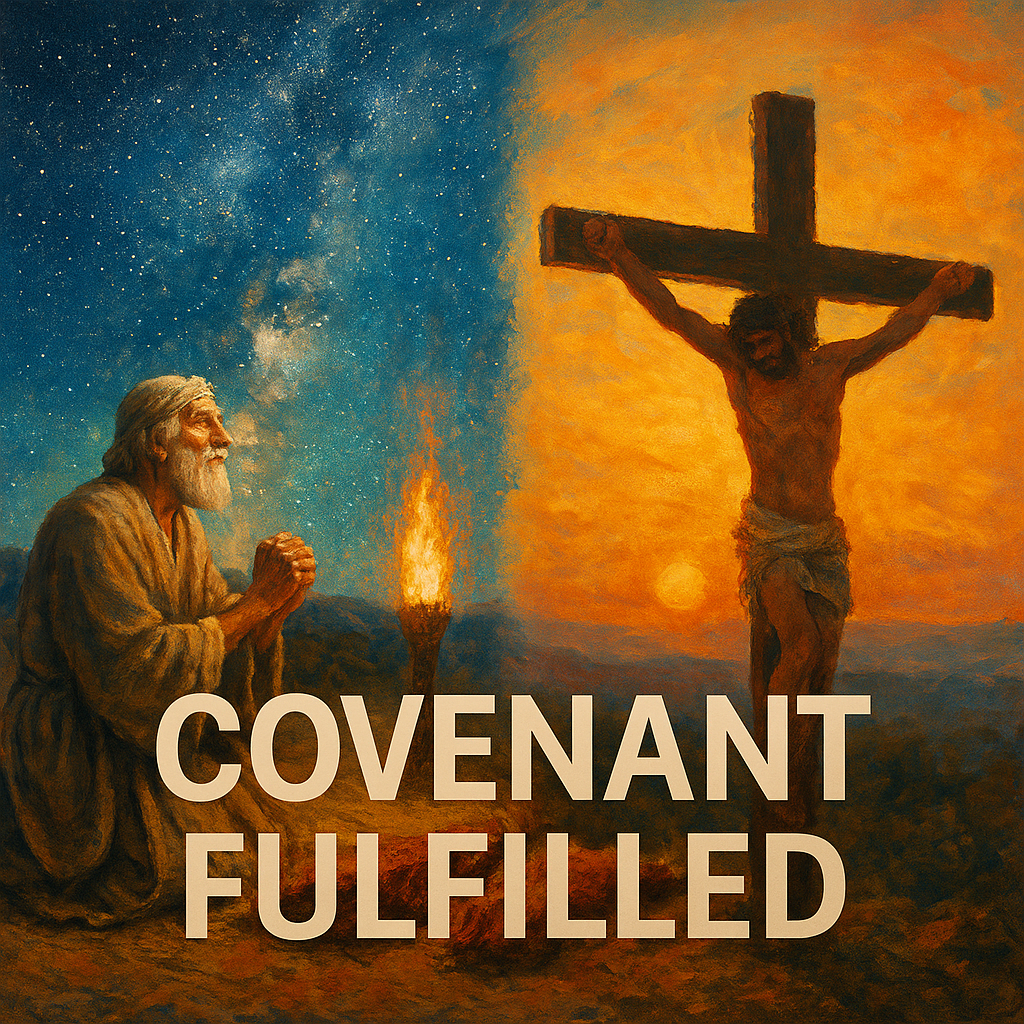The Covenant Confirmed — Blood and Oath (Genesis 15)

The Covenant Confirmed: Blood and Oath
What if the foundation of your faith is not your promises to God, but His oath to you? What if the blood and smoke of Genesis 15 reveal that the God of Abraham bound Himself in covenant—so that His Word could never fail?
This moment in Scripture is not just history. It is the heartbeat of redemption. Genesis 15 shows us a God who does not simply ask for our faithfulness—He pledges His own.
Blood, Oath, and Covenant
When Abram was called, he stood as a single man before the Almighty. Yet what happened under the night sky, with the smoking firepot and the flaming torch passing between the pieces, was more than ritual. It was a divine self-binding. In the Ancient Near Eastern world, covenants sealed with blood were unbreakable. If broken, the violator’s fate was symbolized by the torn animals.
But here is the stunning reversal: God Himself walked through the blood, declaring that if the covenant failed, He would take the penalty upon Himself. The covenant’s weight rested on His shoulders. This is why the New Covenant in Yeshua is not an afterthought—it is the fulfillment of that night in Genesis.
The Hebraic Worldview
As Dr. Michael Heiser reminds us, covenants in the ANE were not abstract. They were legal, familial, and eternal. Dr. Skip Moen points out that Abram’s role was simply to believe—to trust—that the God of Heaven would be faithful.
This is why faith is not mere intellectual assent. Faith is confidence in the reliability of God’s character.
Redemption Secured
From Genesis 15 to the cross, the story is one: God binds Himself to His people. He does not waver. He does not withdraw. His covenant is blood-confirmed and oath-secured.
And if He did this for Abraham, He has done it for you.
Challenge and a Choice
Here is the challenge: Will you live as if your relationship with God depends on your fragile promises, or will you rest in the unshakable covenant God swore in His own blood?
Here is the choice:
•Continue striving in self-reliance, always fearing your own failure.
•Or stand in covenant peace, knowing the Living God has sworn by Himself to redeem you.
Prayer of Salvation
“Avinu Malkeinu” (Our Father, our King),
I come to You with humility and faith. I admit that I have sinned and fallen short of Your glory, just as it is written in Romans 3:23.I turn away from my sins in teshuvah (repentance) and I return to You. I believe that Yeshua HaMashiach (Jesus the Messiah) is the promised Messiah, the Son of the Living God, that He died for my sins, was buried, and rose again on the third day, just as the Scriptures foretold in Isaiah 53, Psalm 22, and 1 Corinthians 15:3–4. Your Word says in Joel 2:32 and Romans 10:13, “Everyone who calls on the Name of Adonai (the Lord) will be saved.” Today, I call on Your Shem HaKadosh (Holy Name). Forgive me, cleanse me, and make me new. Fill me with Ruach HaKodesh (the Holy Spirit) and write Your Torah (teaching, instruction) on my heart, as You promised in Jeremiah 31:33. From this day forward, I choose to follow Yeshua (Jesus) as my Lord, my Redeemer, and my King. Thank You for saving me, making me part of Your covenant people, and giving me eternal life. In the Name of Yeshua HaMashiach (Jesus the Messiah), Melech HaMelachim (the King of Kings), I pray. Amen.
If you prayed that prayer today, I want to welcome you into the family of God! … Contact me and I will help you each step of the Way!
Shalom b’Shem Yeshua.
STUDY GUIDE
This is one of the most profound covenant passages in all of Scripture — Genesis 15 — and when you look at it through Ancient Near Eastern (ANE) language, culture, and context, it explodes with meaning far deeper than we often see on the surface. Let’s walk through the implications.
1. The Covenant Ritual: Cutting of the Animals
In ANE culture, treaties and covenants between kings and vassals were often sealed in a ritual called a “covenant of pieces” (karat berit in Hebrew, literally “to cut a covenant”).
•The animals were cut in half and laid opposite each other, forming a pathway of blood between them.
•Both parties would walk between the pieces, essentially saying: “May what happened to these animals happen to me if I break this covenant.”
Here in Genesis 15, Avram sets up the pieces — but only God (represented by the smoking fire pot and flaming torch) passes through them (v. 17).
•This is radical: God takes the covenant curse upon Himself, binding His own life and reputation to the promise.
•In ANE thought, no king would take all the risk — the weaker party (Avram) should have walked too. But God assumes the penalty alone, making the covenant unbreakable by human failure.
2. Theophany: Fire and Smoke
The smoking fire pot and flaming torch (v. 17) echo Sinai (Exodus 19:18) and later the Temple’s Shekhinah presence. Fire and smoke were ANE symbols of divine presence.
•To Avram, these weren’t abstract — they were the visible signs that the God of the cosmos was lowering Himself to swear a blood-oath to a human.
•In ANE covenant ceremonies, torches, incense, and smoke were also used in rituals of sealing. God adopts familiar symbols — but redefines them to demonstrate His own holiness and faithfulness.
3. The Deep Sleep and Darkness
When Avram falls into a “deep sleep” (tardemah, v. 12), it recalls Adam’s deep sleep in Genesis 2:21. In Hebrew thought, this was not mere fatigue — it was a liminal state between life and death, where God Himself reveals mysteries.
•The “horror and great darkness” show the weight of divine holiness and the cost of covenant.
•In ANE treaty context, this foreshadows the suffering of Avram’s descendants in Egypt. The covenant comes with promise but also with the reality of suffering before fulfillment.
4. Righteousness by Faith
When Avram “believed Adonai, and He credited it to him as righteousness” (v. 6), the Hebrew he’emin (he trusted, placed his full weight on) is covenantal.
•In ANE terms, faith here is not mental assent — it is allegiance. Avram is pledging loyalty and trust to Adonai as his true Suzerain (Great King).
•God responds by crediting this loyalty as tsedaqah (righteousness, covenant faithfulness). In Hebrew thought, righteousness is relational, not abstract morality.
5. Land Grant Formula
Verses 18–21 mirror ANE royal land grant treaties.
•These were unilateral gifts from a king to a loyal servant, not contracts to be negotiated.
•The list of nations is a boundary formula, marking territory under divine claim. This wasn’t just political — in ANE worldview, land was tied to deity and worship.
•God is declaring: “This land belongs to Me, and I covenant to give it to your seed forever.”
6. The Delay of Judgment on the Amorites
Verse 16 introduces a profound Hebraic principle: God’s justice is patient. The Amorites’ sin was not yet “ripe.”
•In ANE cultures, conquest was justified by power. Here, God ties conquest to moral accountability.
•The land promise is not carte blanche; it waits until iniquity reaches its fullness. Covenant blessing is tethered to God’s justice and timing.
7. Implications for Covenant Theology
•Unilateral Grace: In ANE context, covenants were mutual, but Genesis 15 reveals a God who takes all risk. Redemption rests on His faithfulness, not ours.
•Foreshadowing Messiah: God taking the covenant curse upon Himself points straight to Yeshua, who literally bore covenant-breaking’s penalty at the cross.
•Covenant Identity: For Israel, this was not a philosophical idea — it was the foundation of their identity. To belong to this covenant was to live under the protection and kingship of the One who swore by His own Name.
Conclusion
In ANE language and culture, Genesis 15 would have shocked its first hearers:
•A deity who cuts covenant in human terms.
•A deity who takes the death-curse on Himself.
•A deity who ties His Name and reputation to a promise of people, land, and blessing.
For Avram, this wasn’t abstract theology. It was God bending down into the dust of the ANE world, using its very rituals of kingship and blood-oaths, to declare: “I, the Living God, will not fail you. My covenant will stand, even if it costs Me everything.”
Study Notes: Genesis 15 — Covenant of Blood and Oath
1. Historical & ANE Context
•Covenant Ritual (Cutting the Pieces): Common in Ancient Near Eastern treaties. Animals were cut, and both parties walked between them, symbolizing, “May I be as these if I break this covenant.”
•Radical Distinction: In Genesis 15, only God (manifested as smoking fire pot and flaming torch) passes between the pieces. Avram does not. God binds Himself to the covenant — unconditional, irrevocable, anchored in His own Word.
2. Language Insights
•Emunah (faith/belief, v.6): In Hebrew, faith is not abstract belief but covenantal trust, loyalty, and action rooted in relationship.
•“Count the stars” (v.5): Not mere number but ANE idiom for immeasurable and divinely appointed destiny. Stars represented heavenly beings and order; Avram’s descendants would become part of God’s ordered plan.
3. Theological Implications
•God as Shield (magen): More than protection, this word ties into royal and warrior imagery. God pledges Himself as Avram’s Defender and Patron.
•Inheritance Debate: Avram’s question reflects ANE legal norms of adopting a household servant (like Eliezer) as heir. God overturns human custom with divine promise.
•Delay of Promise: God reveals Israel’s future slavery and suffering before inheritance. Blessing is certain but not immediate; it follows divine timing and judgment of the Amorites.
4. Symbolism of the Vision
•Horror and Darkness (v.12): ANE motif of divine presence — terrifying and awe-filled. Foreshadows exile and suffering before redemption.
•Smoking Fire Pot & Flaming Torch: Dual imagery of Sinai theophany — smoke (cloud, mystery, hiddenness of God) and fire (purity, holiness, consuming power). Together they symbolize God’s presence passing through the covenant pieces.
5. Covenant Boundaries
•Extends “from the Wadi of Egypt to the Euphrates.” This sets up not just land promises but divine kingship over nations. The list of tribes reflects Israel’s geopolitical reality in the Late Bronze Age.
6. Conclusions for Today
•Faith is not abstract but rooted in trusting God’s covenant Word.
•God carries the covenant burden Himself — salvation is His work, not ours.
•Suffering precedes inheritance; hardship does not negate God’s promises.
•Covenant faith anchors us when the world spirals into chaos.
Genesis 15, covenant confirmed, blood and oath, Abram faith, Abraham covenant, God’s oath, Hebraic worldview, ANE covenant, Michael Heiser, Skip Moen, covenant theology, unilateral covenant, Messiah, cross of Christ, True Word Faith for LIFE, Dr. Shawn Greener
#Genesis15 #Covenant #Faith #TrueWordFaithforLIFE #FollowerOfTheWay #Messiah #BiblicalTruth





